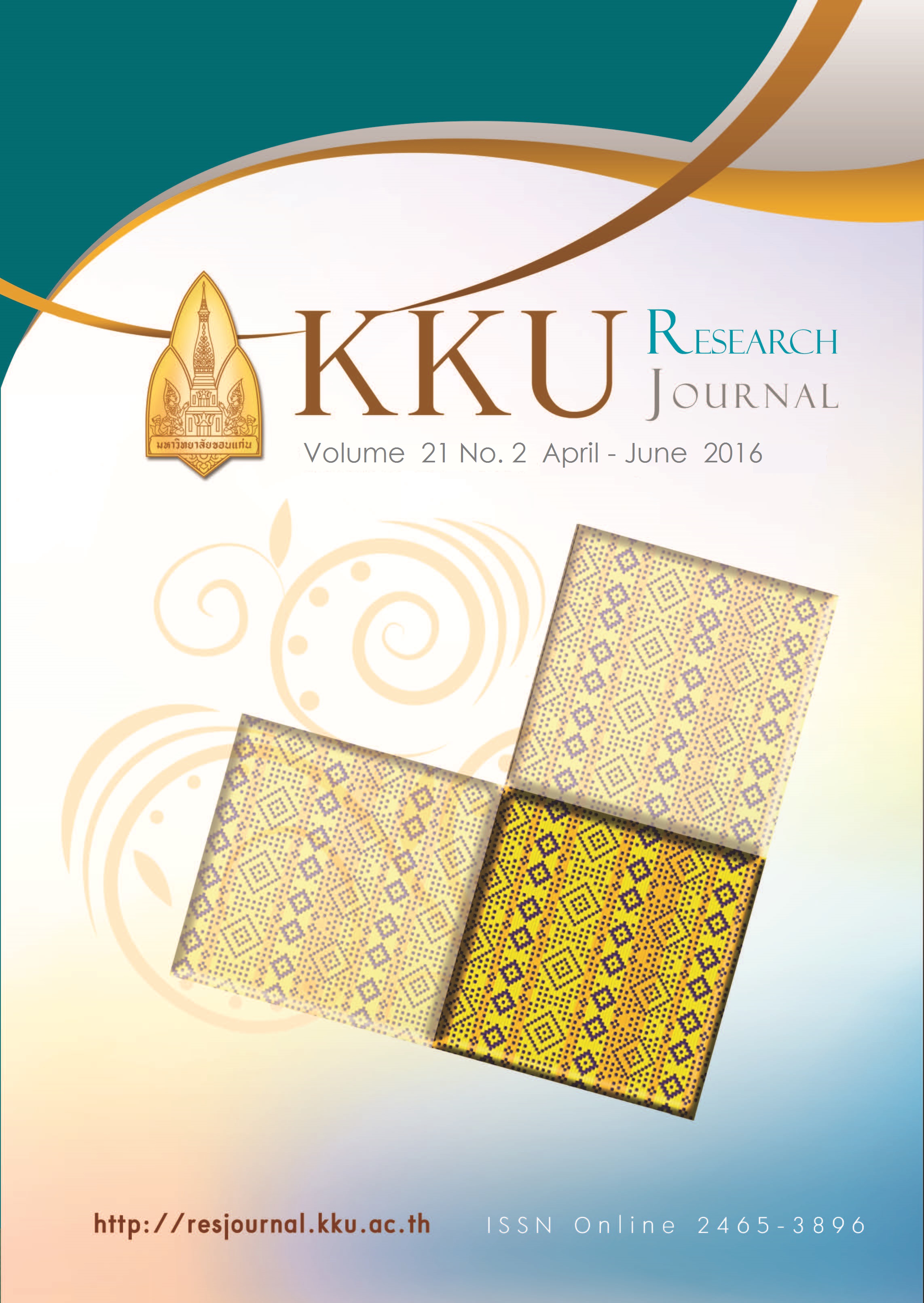Development of coffee pulp extract-incorporated chitosan film and its antimicrobial and antioxidant activities
Main Article Content
Abstract
The aim of this work was to preliminary develop a coffee pulp extract- incorporated chitosan film. Coffee pulp (CP) was obtained from Doi Chaang Original Co. Ltd, Chiang Rai, Thailand. The CP was extracted with distilled water at the CP-to-distilled water ratio of 1:2, and then the mixture was filtered, centrifuged and dried by freeze drying to obtain the dried coffee pulp extract powder (CPE). Chitosan (CH) film incorporated with various concentrations of CPE (0-1.0 % w/v) was prepared by casting method and dried at different temperatures (ambient, 30 and 40 oC). The antimicrobial activity of the films against some potent foodborne microorganisms (Bacillus cereus KCCM 40133, B. subtilis KCCM 11316, Escherichia coli KCCM 21052 and Pseudomonas fluorescence KCCM 11362) was evaluated by disc diffusion method. The antioxidant activity (DPPH assay) and physical properties (water vapor permeability (WVP), solubility and color (L*, a* and b*) of the film were determined. There was no inhibitory effect observed when the CH film without CPE was tested by disc diffusion method. The antimicrobial and antioxidant activities of the CPE-CH films significantly increased with the increasing CPE concentration (p≤0.05). The WVP and solubility of the CH film without the CPE was higher than those of the CPE-CH film. With the increasing CPE concentration in the CH matrix, the WVP and solubility of the CPE-CH film significantly decreased (p≤0.05). These results indicate that the CPE-CH film could be applied as an antimicrobial and antioxidant food packaging.
Article Details
References
[2] Cannel E. and Moo-Young M. Solid- state fermentation systems process bio chem. 1980.;15:2–7.
[3] Dimerci, A. and Pometto, A.L. Repeated fed-batch fermentation in biofilm reactors with plastic composite supports for lactic acid production. Applied microbiology and biotechnology. 1995;43 (4):585-589.
[4] Food and agriculture organization of the united nations (FAO). The global cassava development strategy and implementation plan. Proceedings of the validation forum on the global cassava development strategy; 2000 26-28 April; Rome, Italy.
[5] Huang LP, Dong T, Chen JW, Li N. Biotechnological production of lactic acid integrated with fishmeal waste water treatment by Rhizopus oryzae. Bioproc Biosystems Eng 2007;30:135-40.
[6] Maas RH, Bakker RR, Eggink G, Weusthuis RA. Lactic acid production from xylose by the fungus Rhizopus oryzae. Appl Microbiol Biotechnol 2006;72:861–8.
[7] Miller, G.L. Use of dinitrosalicylic acid reagent for determination of reducing sugar. analytical. chemistry 1959. 31(3):426-428.
[8] Oda, Y., K. Saito., H. Yamauchi and M. Mori. lactic acid fermentation of potato pulp by the fungus Rhizopus oryzae. current microbiology. 2002;45:1-4.
[9] Pandey A., Soccol C.R., Mitchell D.A., New developments in solid-state fermentation. I. Bioprocesses and products, Process Biochem. 2000;35(10):1153–1169.
[10] Senthuran A, Senthuran V, Mattiasson B, Kaul R. Lactic acid fermentation in a recycle batch reactor using immobilized Lactobacillus casei. Biotechnol Bioeng 1997;55:841–53.
[11] Thalisa Yuwa-amornpitak and Kannika Chookietwattana. Lactic acid production from cassava starch by thermothelerent Rhizopus microspores LTH 23.Journal of biological science . 2014; 14(4): 284-291.
[12] Tay, A and S. T. Yang. Production of L(+)-lactic acid from glucose and starch using immobilized cells of Rhizopus oryzae in a rotating fibrous bed bioreactor. biotechnol. Bioeng. 2002;80(1):1-12.


